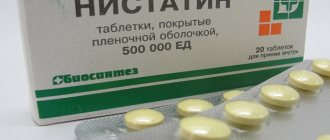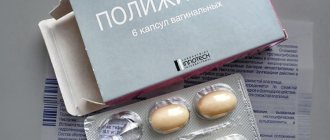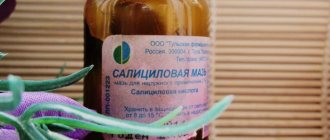Treatment of bacterial vaginosis and candidiasis
20% of women develop candidiasis as a result of treatment for bacterial vaginosis.
This is a fungal infection of the vagina.
The reasons for its occurrence are as follows:
- women with vaginal dysbiosis often have impaired immunity, and this creates the preconditions for the development of thrush;
- fungi love a moist environment, and with vaginosis, discharge is often observed;
- antibiotics are used to treat the disease - the bacteria die, and the fungal flora grows, as the number of competitive microorganisms decreases.
If a doctor assesses a woman’s risk of candidiasis as high, antifungal agents are initially included in the treatment regimen.
This may be miconazole cream or clotrimazole.
Fluconazole is also used orally.
This method is preferable for many women.
After all, local remedies are not easy to use.
They have to be used twice a day for a week.
While when taking fluconazole, one dose of 150 mg is sufficient.
Risk factors
The formation of bacterial vaginosis has a significant difference from the classical course of the infectious disease.
Here the leading role belongs to the inhibition of the body's defenses, a decrease in the number or complete disappearance of Dederlein bacilli (lactic acid bacteria, lactobacilli) and their replacement by facultative flora.
The following conditions may be the reason for this:
- 1Endocrine diseases, hormonal imbalance;
- 2Immunosuppression;
- 3Somatic diseases that contribute to the development of the conditions listed above;
- 4 Diseases of the genitals, accompanied by the entry of a large number of foreign microorganisms into the vagina;
- 5 Violation of mechanical protection factors (damage to the perineum, genital tract, intrauterine contraceptives);
- 6Massive, frequent and inadequate antibacterial therapy.
Another difference between bakvaginosis and an infectious disease is the absence of any single pathogen (Gardnerella, mycoplasma, staphylococcus, etc.).
When comfortable conditions arise, the amount of a more aggressive opportunistic environment increases, the number of lactobacilli decreases, and the acidity of the vaginal environment shifts to the alkaline side.
All this leads to intensive growth of facultative flora, the formation of pathological biofilms, and the appearance of discharge with a specific unpleasant odor.
During the life of opportunistic microorganisms, amines (putrescine, cadaverine, trimethylamine and others) are released. One of the tests aimed at identifying vaginal dysbiosis, the amine test, is based on this feature.
Restoration of vaginal and intestinal microflora after treatment of bacterial vaginosis
The most important stage of therapy is the restoration of microflora.
It is not enough to destroy “bad” bacteria.
We still need to populate the vagina with “good” microbes.
They will produce lactic acid, hydrogen peroxide.
Therefore, they prevent the recurrence of bacterial vaginosis.
Standards for the treatment of bacterial vaginosis require a two-stage treatment regimen.
At the first stage, antimicrobial agents are prescribed.
That is, all the actions described above are performed.
After this, a break is taken for several days.
At the second stage, after treatment of bacterial vaginosis, probiotics are prescribed.
Their use simultaneously with antibacterial therapy is inappropriate.
This is simply pointless, because antimicrobial agents destroy not only gardnerella and other anaerobes.
They also suppress lactobacilli.
Therefore, it is important that antibacterial substances leave the blood.
Only after this are lactobacilli prescribed in the form of vaginal suppositories.
The effectiveness of the two-stage treatment regimen is quite high – it reaches 90%.
How to recognize vaginal dysbiosis?
Differential diagnosis of the disease is carried out with inflammatory processes of the vagina (nonspecific colpitis, candidiasis, gonorrhea, trichomonas colpitis). To establish a diagnosis, the gynecologist collects a detailed medical history and studies the patient’s complaints.
Inspection - during examination of the walls of the vagina/cervix, homogeneous (homogeneous) discharge in the form of cream or cream of a whitish or grayish hue, with an unpleasant fishy bouquet and in large quantities, is found on the vaginal walls. This is one of the signs of vaginal dysbiosis.
Smear - the second characteristic feature is the visualization of “key” cells in the native material. “Key” cells are desquamated epithelial cells with gram-variable bacteria (gardnerella, mobilincus and others) attached to them.
In addition to detecting “key” cells, smear microscopy allows us to establish that epithelial cells predominate over leukocytes (there is no inflammatory reaction, see the reasons for the increase in leukocytes in the smear) and the number of Doderlein rods is less than 5 in the smear.
Acidity - it is also necessary to determine the pH of the vaginal environment. To do this, a special pH-sensitive strip is immersed with tweezers into the posterior vaginal fornix, where there is the greatest accumulation of secretions.
And the diagnosis is confirmed by the appearance of a rotten fishy smell when mixing vaginal leucorrhoea and 10% potassium alkali (KOH) in equal quantities (volatile amines are released as a result of a chemical reaction).
The diagnosis is established when three out of a possible four signs are positive.
Treating bacterial vaginosis without antibiotics at home
Naturally, all patients are treated for bacterial vaginosis at home, albeit under the supervision of a doctor.
No one hospitalizes women just because they have discharge and an unpleasant odor from the vagina.
However, when people are interested in the topic of home treatment, in most cases they mean the possibility of getting rid of the disease without the help of gynecologists at all.
And often even without the help of the pharmaceutical industry.
Various “grandmother’s recipes”, folk remedies, spells and other methods with dubious effectiveness are used.
Let's look at the basic recommendations that can be found on the Internet regarding home treatment for bacterial vaginosis.
Symptoms of the disease
Discharge from bacterial vaginosis
Bacterial vaginosis is often asymptomatic, especially in the early stages of the disease. Sometimes, with minor disturbances in the microflora, the body itself is able to regulate the deviations.
A distinctive symptom of the disease is vaginal discharge - leucorrhoea. They are usually white or with a grayish tint, liquid with an unpleasant, stale odor. Their number may vary, but in any case exceeds the volume of daily secretions.
If the symptoms of the disease do not decrease in manifestations against the background of the treatment received, chronic bacterial vaginosis occurs. In this case, periods of exacerbations are replaced by remission, and the disease becomes protracted.
With chronic bacterial vaginosis, the leucorrhoea becomes denser, stickier, and has a green or yellow tint. In addition, the following symptoms are noted:
- itching, burning;
- discomfort during sex;
- pain when urinating.
Is it necessary to treat a partner for bacterial vaginosis?
Bacterial vaginosis is not a sexually transmitted infection.
Moreover: there is no one specific causative agent of this disease.
Gardnerella vaginalis often plays a leading role in this process.
However, this microorganism is not detected in all cases.
It has been established that gardnerella can be transmitted to men during sexual intercourse.
Moreover, they can cause inflammatory processes in some cases.
Gardnerella is the causative agent of urethritis and anaerobic balanoposthitis.
Moreover, in the case of immunodeficiency, these pathologies are quite severe.
However, treatment is not prescribed to the partners of those women who have bacterial vaginosis without special indications.
The fact is that:
- Gardnerella is almost always present in a woman’s genital tract, the only problem is that with tank vaginosis there are more of these bacteria;
- A man can become infected with Gardnerella from a woman even if she does not have vaginal dysbiosis;
- Not every case of bacterial vaginosis is caused by gardnerella;
- When a man is infected with these bacteria, in most cases there are no symptoms, and the microorganisms themselves are eliminated after a few days.
In the male genitals there are no favorable conditions for the growth of Gardnerella vaginalis.
These bacteria usually die soon after entering the genitourinary system.
Therefore, the man does not require treatment.
It is necessary only in isolated cases.
Namely, in case of established inflammatory processes caused by anaerobic microflora.
In this case, the partner is treated at the same time as the woman.
The same antimicrobial drugs are used.
Classification of vaginal dysbiosis
According to the severity of vaginal dysbiosis, there are:
- compensated or grade 1 (there is no microflora in the smear, epithelial cells are present without changes and the possibility of infection with other pathogenic microorganisms remains);
- subcompensated or degree 2 (the content of Doderlein bacilli decreases, gram-negative and gram-positive flora increases, there are from 1 to 5 “key” cells, a slight increase in leukocytes - up to 15 - 25);
- decompensated or 3rd degree (no lactic acid bacteria, there is a clinical picture of the disease, “key” cells entirely, various pathogenic and facultative or opportunistic microorganisms).
According to the flow, acute, torpid or erased and asymptomatic vaginal dysbiosis is distinguished.
Odor and discharge after treatment for bacterial vaginosis
Sometimes, after a course of therapy, a woman still has symptoms of bacterial vaginosis.
This suggests that the treatment was ineffective.
Anaerobic bacteria still form the basis of the vaginal biocenosis.
This can happen for the following reasons:
- underexamination, resulting in an incorrectly selected treatment regimen;
- a correctly selected regimen, but not followed medical recommendations (many patients stop treatment earlier than planned or do not take all prescribed medications).
Our clinic uses modern, highly effective treatment regimens.
When using them, no symptoms remain after the end of the course.
Prevention
10.1. Vaccination
Currently, nonspecific vaccination is possible, aimed at activating specific and nonspecific immunity using the SolkoTrichovak vaccine.
Vaccination involves three intramuscular injections of the vaccine with an interval of 14 days. The first injection is performed the day after the end of the course of antibiotic therapy. The method is experimental, but, according to the authors, quite effective.
10.2. General preventive measures
- 1Maintaining normal immune status.
- 2Limiting the harmful effects of the environment on the body, minimizing stress.
- 3Control and maintenance by a woman of her gynecological health: regular visits to the gynecologist, timely treatment of diseases, maintaining a healthy sex life with a regular partner, maintaining personal hygiene, wearing natural underwear made from natural materials that does not restrict movement.
- 4The proliferation of opportunistic infections is often caused by the patient’s uncontrolled use of systemic antibiotics to treat concomitant pathologies. Therefore, the prescription and administration of antibacterial drugs should be carried out under the strict supervision of the attending physician.
- 5Restoring hormonal balance.
- 6Suppression of disease relapses: it is necessary to monitor the effectiveness of therapy 1 week and 4-6 weeks after the end of the course.
Video Photo Tables
| Type of flora | Microorganisms |
| Predominant obligate (obligate) permanent (resident) flora | Lactobacillus (dominant); Lactococcus; Bifidobacterium; Aerococcus. |
| Facultative resident flora (with high adaptation to a given organism) | Propionbacterium; Eubacterium; Bacteroides; Prevotella; Peptococcus; Peptostreptococcus; Gardnerella; Corynebacterium spp. |
| Opportunistic optional-resident | Clostridium; Veilonella; Fusobacterium; Enterococcus; Staphylococcus (coagulase negative); Streptococcus (alpha and gamma hemolytic, greening) |
| Potentially pathogenic facultative resident | Mycoplasma; Ureaplasma; Chlamydia; Mobiluncus; Leptotrichia; Candida; E. coli; Streptococcus (beta-hemolytic, GBS) |
| Potentially pathogenic, poorly adapted to a given macroorganism, some species are pathogenic | Enterbacteriacaea; Micrococcus; Neisseria spp. Campilobacter |
Sex before and after treatment for bacterial vaginosis
Women often wonder whether it is possible to continue to be sexually active with established vaginal dysbiosis.
As we have already said, this condition is not a sexually transmitted infection.
Many women live with dysbiosis for years.
Some people tolerate the symptoms that arise.
Others don't notice them at all.
All this time, women continue to lead an intimate life.
And men do not become infected with anything from them.
Therefore, you can have sex before, during and after treatment.
This does not pose any risks to the sexual partner.
The exception is when:
- concomitant STDs were identified;
- mycoplasmas and ureaplasmas were detected;
- During treatment for dysbiosis, candidiasis developed.
You may then need to take a break from sexual relations or use a condom to protect your partner from infection.
How does bacvaginosis manifest?
Despite the fact that the disease is not a sexually transmitted infection, its occurrence is often associated with sexual intercourse, especially when changing partners. Signs of bacterial vaginosis in women develop on average one day after intercourse, if it occurred without a condom. If the cause of the disease is the use of antibiotics and other medications, changes in hormonal levels (menopause), then the symptoms of bacterial vaginosis develop regardless of sexual activity.
Acute vaginosis manifests itself:
- discharge from the genital tract: it has a grayish-white color, uniform consistency, and an unpleasant “fishy smell.” Their quantity may vary, as a rule, they become more abundant after menstruation, intercourse, or the use of irritating detergents;
- pain during sexual intercourse;
- discomfort, itching and burning in the genitals. These signs are usually weak or absent;
- Rarely, a woman experiences pain, pain when urinating, and abdominal pain in the suprapubic area.
Chronic bacterial vaginosis is a continuous course of the disease for more than 2 months, despite treatment. As a rule, it is combined with hormonal imbalance and atrophy of the vaginal mucosa.
Treatment of bacterial vaginosis during pregnancy
Bacterial vaginosis is one of the most common female diseases.
It is detected in 20% of all women.
But vaginal dysbiosis is diagnosed even more often in pregnant women.
Among them, the incidence of bacterial vaginosis reaches 30%.
This is due to hormonal changes and physiological immunosuppression.
Having bacterial vaginosis during pregnancy increases the risk of:
- premature discharge of amniotic fluid;
- birth of premature babies;
- postpartum endometriosis.
Therefore, all pregnant women are subject to treatment.
Including in the case of asymptomatic vaginal dysbiosis.
But nitroimidazoles are contraindicated in the first trimester.
They may have a toxic effect on the fetus.
Therefore, metronidazole or drugs with a similar mechanism of action are used only starting from the 2nd trimester.
They can be used in tablets or local forms (gel, vaginal suppositories).
Using drugs for vaginosis: suppositories
Vaginal medications have their own characteristics.
- Most often, such drugs require compliance with storage conditions. If the manufacturer recommends keeping the medicine cold, then this must be done.
- Most medications are taken once a day. In this case, suppositories should be administered before bedtime. After use, you must remain in a horizontal position for 15 minutes to an hour.
- Some medications should not be used during menstruation. It is necessary to take this information into account and choose the right time for treatment. There are drugs that prohibit sexual activity during treatment.
- Vaginal suppositories should only be inserted with clean hands.
Modern medicine allows the use of various medications for vaginosis. Suppositories with a certain active ingredient are prescribed to the patient after the examination. Diagnostics includes an analysis to identify the causative agents of the pathology, of which there are usually several.
When to get pregnant after treatment for bacterial vaginosis
The presence of bacterial vaginosis is not considered a contraindication to pregnancy.
This pathology does not affect fertility and does not reduce the chances of conception.
However, dysbiosis can cause complications during pregnancy.
Therefore, it is better to get rid of it before getting pregnant.
After a course of antibacterial treatment, you can immediately try to conceive a child.
The main thing is to undergo therapy before pregnancy.
Because drugs used to suppress anaerobic flora are dangerous for the fetus in the first trimester.
The most common symptoms of bacterial vaginosis
How do you know if you have a bacterial infection?
The most common signs and symptoms of vaginal bacterial infections include:
- Changes in discharge. They can range from white, off-white to grayish in color.
- The discharge may be larger than usual or accompanied by a musty/fishy odor.
- Sometimes the discharge may be lumpy, creamy, foamy, or change from gray to white or yellow-green. This may cause changes in urination, such as cloudy urine .
- Some women experience pain while urinating, in the shower, or during/after sex.
- A burning sensation can occur when showering and using certain soaps because it can make the vagina even more alkaline and irritated. Naturally, your skin secretes a slightly acidic secretion to protect itself. When this secretion becomes too alkaline, soap can make the problem worse. Most foaming soaps are alkaline based and contain ingredients such as glycerin, lye soap or sodium hydroxide because they help dissolve acidity and remove germs.
- The skin in and around the vagina may be irritated, tender, and red.
When to see a doctor
Make an appointment at a clinic or medical center if:
- Vaginal discharge looks new or unusual, has a foul odor, or is accompanied by a fever. A gynecologist will help identify the cause and diagnose the disease based on signs and symptoms.
- You have treated vaginal infections before, but this time the discharge has a different color and consistency.
- You have had sex with multiple partners or have recently changed partners. Sometimes the symptoms of sexually transmitted diseases are similar to those of bacterial vaginosis.
- You tried to treat a yeast infection yourself with over-the-counter medications, but you ended up with bacterial vaginosis, the symptoms of which don't go away.
Diagnostics
Bacterial vaginosis is diagnosed based on the results of a gynecological examination, bacterioscopic examination and calposcopy. An amino test and analysis are also performed to determine the pH of the vagina. As part of the examination for bacteriosis, thick discharge will be detected in the absence of visible signs of inflammation on the walls of the vagina. As a result of microscopy, the following will be revealed:
- Presence of leukocytes;
- Increase in pathogenic flora;
- Indistinct edges of key epithelial cells;
- Reducing the number of lactobacilli.
Vaginosis: treatment
Therapy for bacterial vaginosis is carried out in stages. Therefore, all causes of the development of imbalances in the vaginal microflora are initially eliminated. It is possible that they will stimulate the immune system, correct hormonal levels, etc. Next is the stage of using antibacterial agents and restoring the balance of the vaginal microflora. But the patient does not always need treatment for bacterial vaginosis. Sometimes the doctor may opt for a wait-and-see approach, especially if the woman does not experience any discomfort and does not report pronounced symptoms of vaginosis.
How to treat bacterial vaginosis
Preventive therapy for vaginosis is necessary before abdominal surgery or invasive gynecological procedures.
Combination therapy for vaginosis can be as follows:
- Metronidazole tablets for 5-7 days.
- Metronidazole in the form of a gel for intravaginal use.
The effectiveness of therapy is determined by several factors, including the results of repeated laboratory tests. Dynamic changes in signs of vaginosis are taken into account.
After starting treatment for bacterial vaginosis, approximately 2 weeks later the patient must undergo a follow-up laboratory examination.
Treatment of vaginosis during pregnancy
During pregnancy, vaginosis is quite insidious and even if the results of smears indicate an increased number of pathogenic microorganisms, the woman may not complain of any symptoms. In this case, the attending physician will most likely not prescribe medication, but will only monitor the dynamics of the development of the condition.
If vaginosis during pregnancy is clinically pronounced, then therapy is selected individually and may include antibacterial drugs and eubiotics. More than one specialist will not be able to tell you exactly and unambiguously at the first appointment how to treat bacterial vaginosis. In any case, a comprehensive diagnosis is needed.
Bacterial vaginosis: drugs
For vaginosis, complex therapy is used, aimed at eliminating the causes of disturbances in the vaginal microflora, as well as antimicrobial drugs and eubiotics.
The final stage of treatment for bacterial vaginosis requires special attention - this is restoring the balance of the vaginal microflora. In addition, this is one of the most difficult therapeutic stages, and achieving positive results is not so easy even for a competent doctor.
You need to know that the use of only vaginal suppositories of eubiotics is rarely considered by the attending physician. Preference is given to complex treatment using both internally and locally. Thus, a specialist can recommend Linex, Hilak Forte or, for example, Baktisubtil.
Antibiotics for vaginosis
When treating vaginosis, antibacterial medications are prescribed.
- This could be Metronidazole, an antiprotozoal and antimicrobial agent. Moreover, when treating bacterial vaginosis, as a rule, this drug is prescribed at a dose of 0.5 g several times a day for 1 week.
- Povidone-iodine suppositories are a good antibiotic prescribed for vaginitis. Use suppositories several times a day for 1 week.
- Ornidazole is one of the most common drugs for vaginosis. Take the antibiotic several times a day for 5 days.
- Another effective antibacterial drug is Clindamycin. Use the drug for vaginosis for 1 week several times a day.
Suppositories for bacterial vaginosis
Suppositories are one of the most common dosage forms successfully used in the treatment of bacterial vaginosis. The doctor may prescribe different suppositories, depending on the clinical picture and age of the patient.
- Neo-penotran is an excellent drug with antibacterial and antifungal effects. This medication can be prescribed even during gestation, mainly after 20 weeks. The course of treatment for vaginosis with Neo-penotran is 10 days.
- Hexicon is a suppository for bacterial vaginosis with an excellent antibacterial effect, and this medication does not affect the activity of lactic acid bacteria.
- Metronidazole is a well-established medication for the treatment of vaginosis. In addition, this remedy is also effective for vaginosis, the development of which is caused by the proliferation of Trichomonas in the vaginal environment. The average course of treatment is 6 days.
- Clindamycin is a drug with an antibacterial effect. These are good suppositories for bacterial vaginosis, used at different stages of development of the condition.
- Bifidumbacterin is a good drug that helps restore vaginal microflora. These suppositories are prescribed 1 per day for 7-10 days.
- Ecofemin - this product restores the vaginal microflora. The therapeutic course is about 7-10 days.
All presented suppositories for bacterial vaginosis cannot be used without consulting a doctor. Only a competent specialist will determine the causes of vaginal microflora disorders and select medications on an individual basis.
Vaginosis: folk remedies
For the treatment of vaginosis, folk remedies are used quite often, since they can be used to complement effective drug therapy. It is important not to change the treatment regimen prescribed by the doctor and continue therapy until the problem is completely eliminated, which should be confirmed by appropriate tests.
Additionally, bacterial vaginosis can be treated with tinctures of medicinal plants, which should be taken orally. Among them, the most effective are the following: Leuzea root, sweet clover, cudweed, lavender flower, elecampane root, birch leaves, licorice, thyme, geranium leaves, meadowsweet, etc.
Tinctures from all of these mixtures are prepared and used according to the same principle. You need to mix certain ingredients in equal parts. Then 2 tbsp. spoons of the resulting mixture are steamed with boiling water (1 liter). After 5-7 hours, you can drink the tincture 1/2 glass 3 times a day, always before meals. The course lasts 2-3 months, which the attending physician will definitely tell you.
In addition to internal use for vaginosis, folk remedies (decoctions of medicinal plants) are used for baths. In addition, your doctor may prescribe douching. For this you may need the following mixtures:
- blueberry (berry), birch leaves, tansy color, Greek;
- oak bark, geranium leaves, wormwood, chamomile blossom, violet blossom, etc.
These mixtures are prepared and used as follows. The necessary ingredients are taken in equal shares. The resulting mixture (2 tablespoons) is steamed with boiling water (1000 ml) and infused for approximately 7-8 hours. Then the tincture is filtered and used for douching. For one douching you will need 1 glass of decoction.
But before you take into account information about douching, it is important to take into account the fact that such therapy is permissible for use only under the strict recommendations of a specialist. The fact is that incorrect or frequent douching changes the level of acidity and further disrupts the balance of the vaginal microflora.
Washing with herbal infusions is also practiced for vaginosis. This can be a prepared solution from walnut and sage leaves, chamomile flowers, or oak bark. Another common recipe is a mixture of coltsfoot leaves and juniper (fruits).
When treating vaginosis, folk remedies are sometimes recommended for use in baths. To do this, pour 2 cups of a pre-prepared decoction of specific medicinal herbs into water at a comfortable temperature (10 liters) and mix. The procedure lasts from 15 to 25 minutes. It should be noted that such baths bring very good results in cases where bacterial vaginosis is accompanied by severe itching.
Before treating bacterial vaginosis with tinctures for internal use, you should think about individual intolerance to one or another ingredient. If there is none, it will not be difficult to cure vaginosis with folk remedies and medications if used correctly and regularly, but only under the guidance of a doctor.
Traditional medicine requires serious consideration. Self-medication or correction of the treatment regimen prescribed by the doctor is unacceptable. It is important to know that incorrectly selected or used infusions and decoctions of herbs can aggravate the situation with vaginosis and provoke the development of side effects and allergies.
How to treat bacterial vaginosis with folk remedies
Before starting a course of therapy, it is recommended to consult a doctor to avoid complications and side effects. With the right approach, the use of folk recipes helps relieve unpleasant symptoms and restore healthy vaginal microflora.
Douching solutions:
- soak 250 grams of oak bark in cool water, leave for 2-3 hours, boil the mixture, add to a previously prepared bath. The treatment procedure eliminates inflammation and promotes wound healing;
- combine walnut leaves, oat straw, juniper berries, chamomile, oak bark. Boil for 30-40 minutes over low heat, add the broth to the prepared bath. The product has antimicrobial, antiviral, antifungal effects.
Diagnosis of vaginosis
The microbiocenosis of the vagina undergoes changes with bacterial vaginosis. The number of lactobacilli decreases, and bacteroides, mycoplasmas, and gardnerella begin to predominate in the vaginal microflora.
Disturbances in the vaginal microflora are determined based on the results of laboratory tests, a gynecological examination in a chair and taking into account the patient’s complaints. It is not difficult for a competent doctor to identify bacterial vaginosis. A gynecological examination reveals mucopurulent discharge, but there is no inflammation of the mucous membrane.
If the attending physician discovers additional diseases, then, most likely, consultations with different specialists will be needed. This could be a venereologist, a mycologist, or an endocrinologist. It is possible that pelvic ultrasound diagnostics, biochemical blood tests, hormone tests, etc. will be prescribed.
It is also important to know that when diagnosing a patient, the doctor must differentiate vaginosis from trichomoniasis, nonspecific vaginitis and gonorrhea. It is necessary to make an accurate diagnosis, so if there is the slightest doubt, the specialist will prescribe a set of additional diagnostic procedures.
Tests for vaginosis
If vaginosis is suspected, the doctor will make a smear for microscopic examination. The effectiveness of this diagnosis is extremely high. Confirming vaginosis, if present, is not difficult.
Bacteriological laboratory testing is an ideal option if the doctor suspects an infectious lesion accompanying bacterial vaginosis. An amino test and determination of the acidity level of vaginal secretions may also be recommended. Tests for vaginosis are extremely important, because without their results it is impossible to accurately determine the problem and prescribe an adequate and effective solution.
If a woman suspects she has vaginosis, she should go to a gynecologist immediately. Unfortunately, the symptoms of such an imbalance of the vaginal microflora are non-specific, so the signs can be confused with other diseases, including infectious ones.
Causes of vaginosis
The causes of vaginosis can be various sexual diseases, endocrine system disorders, and decreased immunity.
Vaginosis can occur for a number of reasons. Here are most of the possible disorders and conditions that contribute to the appearance of bacterial vaginosis:
- uncontrolled use of antibiotics that kill milk bacteria;
- endocrine system disorders;
- genitourinary diseases;
- decreased immunity;
- use of oral contraceptives;
- predisposition to allergies;
- frequent change of sexual partners, unprotected sex;
- frequent douching;
- violation of intimate hygiene rules;
- frequent wearing of tight synthetic underwear and pads that prevent oxygen access;
- abortions.
Bacterial vaginosis never appears “out of nowhere”; its appearance is caused by other diseases, and this process should be considered as common to the entire female body. In each case, it is necessary to identify the causes of bacterial vaginosis and the factors predisposing to this disease. In each individual case, it is necessary to eliminate not only the symptoms, but also the causes of vaginosis.
Provoking factors
Taking hormonal medications
- Taking antibacterial drugs, hormones, antidepressants;
- Use of an intrauterine contraceptive (spiral, diaphragm, etc.) for a long time;
- Frequent use of tampons for a long time;
- Menstrual irregularities;
- Age-related changes in the body (menopause);
- Changes after childbirth, abortion;
- Traumatic injury to the genital organs;
- Weakening of the immune system;
- Violation of personal hygiene of the genital organs;
- Stressful situations.
Intrauterine device
Bacterial vaginosis does not belong to the group of diseases transmitted through sexual contact. However, sexual behavior is important in the development of this disease. The onset of sexual activity at the age of 14-15 years, its characteristics, and the number of sexual partners are all risk factors for the development of lactobacilli deficiency syndrome. I would especially like to note that it is the number of sexual partners that is more significant in the development of the disease than the number of sexual contacts.
Preventive measures
To prevent vaginosis, a healthy lifestyle and regular visits to the gynecologist are necessary.
At the same time, every woman can independently prevent the development of bacterial vaginosis. The modern drug Lactagel will protect female microflora from attack by foreign bacteria. The packaging in the form of a syringe tube is very convenient for self-administration of the drug into the vagina.
When and in what cases should Lactogel be used?
- At the end of menstruation and immediately after it ends, a woman becomes especially vulnerable. During this period, the vaginal pH level, usually 7.0, drops to 4.5, which certainly increases the risk of infection.
- Symptoms of vaginosis can occur with intestinal dysbiosis. And if you are diagnosed with this disease, then in 50-55% of cases you may develop vaginal dysbiosis.
- If you have been diagnosed with bacterial vaginosis and your doctor has prescribed treatment, Lactagel will significantly reduce its duration.
- Antibiotics prescribed by a doctor are a reason for the prophylactic use of this drug, of course, only after prior consultation with the treating doctor.
Tags: women's











